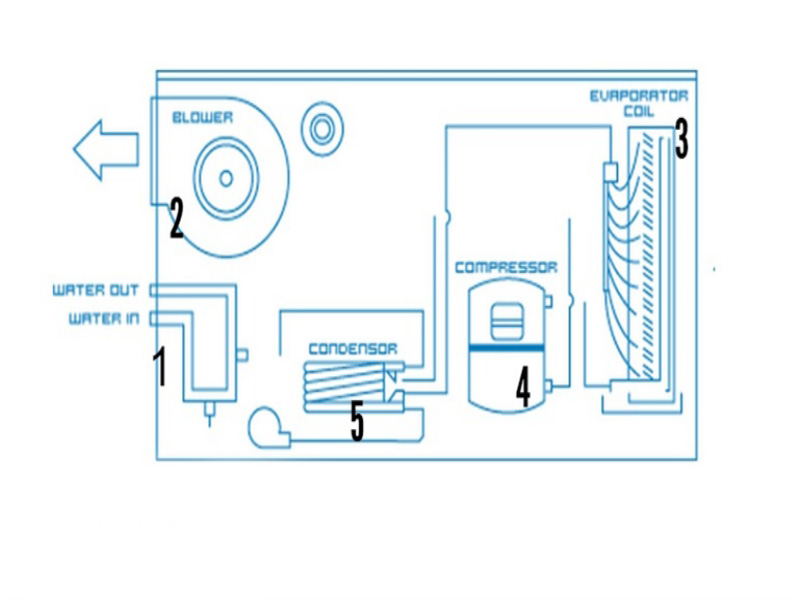In the current situation of energy supply trends and increasing environmental protection requirements, people are constantly seeking new energy products that are both energy-saving and environment-friendly. Thus, air source heat pumps (ASHP) are prevailing worldwide. This kind of renewable equipment can make use of the energy in the air to achieve the heating effect without the discharge of harmful substances, so no secondary pollution is produced. Generally, the ASHP unit is installed in an open place. If the installation position is not well ventilated, it will affect the operation effect. Therefore, this article will share the correct installation methods regarding swimming pool air source heat pump.
The normal operation of ASHP needs to satisfy the following three factors: smooth fresh air, corresponding power supply, appropriate water flow, etc. The unit shall be installed in the outdoor place with good ventilation and easy maintenance, and shall not be installed in a narrow space with poor air. At the same time, the unit must be kept at a certain distance from the surrounding area to make sure that the air is unblocked. Also, the sundries should not be stacked at the place where the air enters and exits the unit so as to avoid the reduction of its heating efficiency. The installation standard is as follows:
Installation Environment
1. Generally, ASHP can be placed on the roof or the ground adjacent to the building where the equipment is used, and it should be far away from the place where the flow of people is relatively dense, in order to prevent the impact of air flow and noise on the environment during the operation of the unit .
2. When the unit is of a side air inlet, the distance between the air inlet surface and the wall shall not be less than 1m; when two units are placed facing each other, the distance shall not be less than 1.5m.
3. When the unit is of a top discharge structure, the open space above the outlet should not be less than 2m.
4. Only one side of the partition wall around the unit is allowed to be higher than the unit height.
5. The unit’s foundation height shall not be less than 300mm, and it should be greater than local snow thickness.
6. The unit shall be set with measures to eliminate a large amount of condensate produced by the unit.
Requirements of the Water System
1. Install the air source heat pump swimming pool unit at the downstream of all filtering devices and swimming pool pumps, and upstream of chlorine generators, ozone generators and chemical disinfection. PVC pipes can be directly used as water inlet and outlet pipes.
2. Generally, the ASHP unit should be installed within 7.5m from the pool. And if the water pipe of the swimming pool is too long, it is recommended to use 10mm thick insulation pipe, so as to avoid insufficient heat production due to excessive heat loss of the unit.
3. The water system design needs to be equipped with a loose joint or flange on the water inlet and outlet of the heat pump, so as to drain water in winter, which can also be used as a check point during maintenance.
5. The water system must be equipped with water pumps with appropriate water flow and water-lift to ensure that the water flow meets the requirements of the unit.
6. The water side of the heat exchanger is designed to withstand water pressure of 0.4MPa. In order to prevent damage to the heat exchanger, overpressure is not allowed.
7. During the operation of the heat pump, the air temperature will be reduced by about 5℃. Condensate water will be generated on the fins of the evaporator and fall on the chassis, which will be discharged through the plastic drain nozzle installed on the chassis. This is a normal phenomenon (condensate water is easily mistaken for water leakage of the heat pump water system). During the installation, drainage pipes must be installed to drain the condensate water in time.
8. Do not connect the running water pipe or other water pipes to the circulating pipe. This is to avoid the damage to the circulating pipe and the heat pump unit.
9. The water tank of the hot water heating system shall have good heat preservation performance. Please do not install the water tank in the place with corrosive gas pollution.
Electrical Connection
1. The socket must be reliably grounded, and the capacity of the socket should meet the current power requirements of the unit.
2. No other electrical equipment shall be placed around the unit’s power socket so as to avoid plug tripping and leakage protection.
3. Install the water temperature sensor probe into the probe tube in the middle of the water tank and fix it.
Remark:
Some of the articles are taken from the Internet. If there is any infringement, please contact us to delete it. If you’re interesting in heat pump products,please feel free to contact OSB heat pump company,we are your best choice.
Post time: Jul-09-2022


